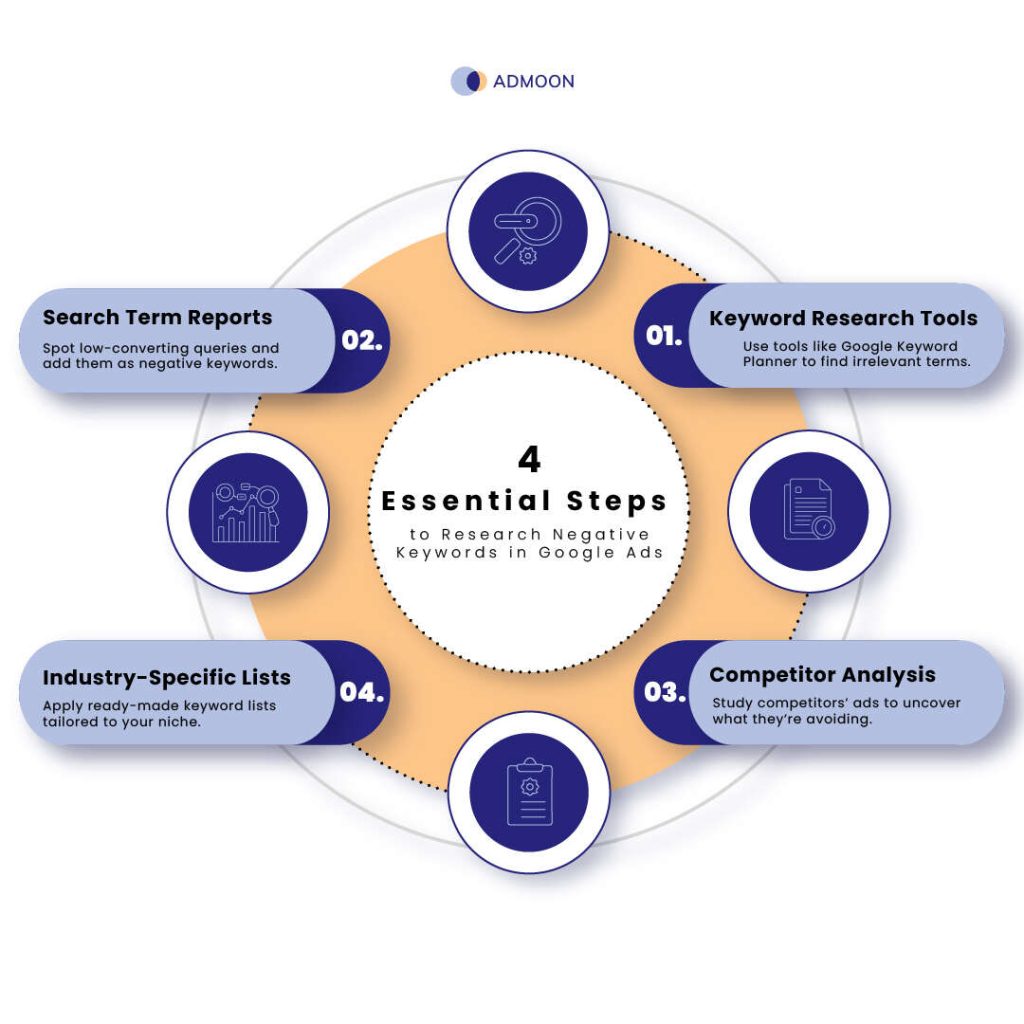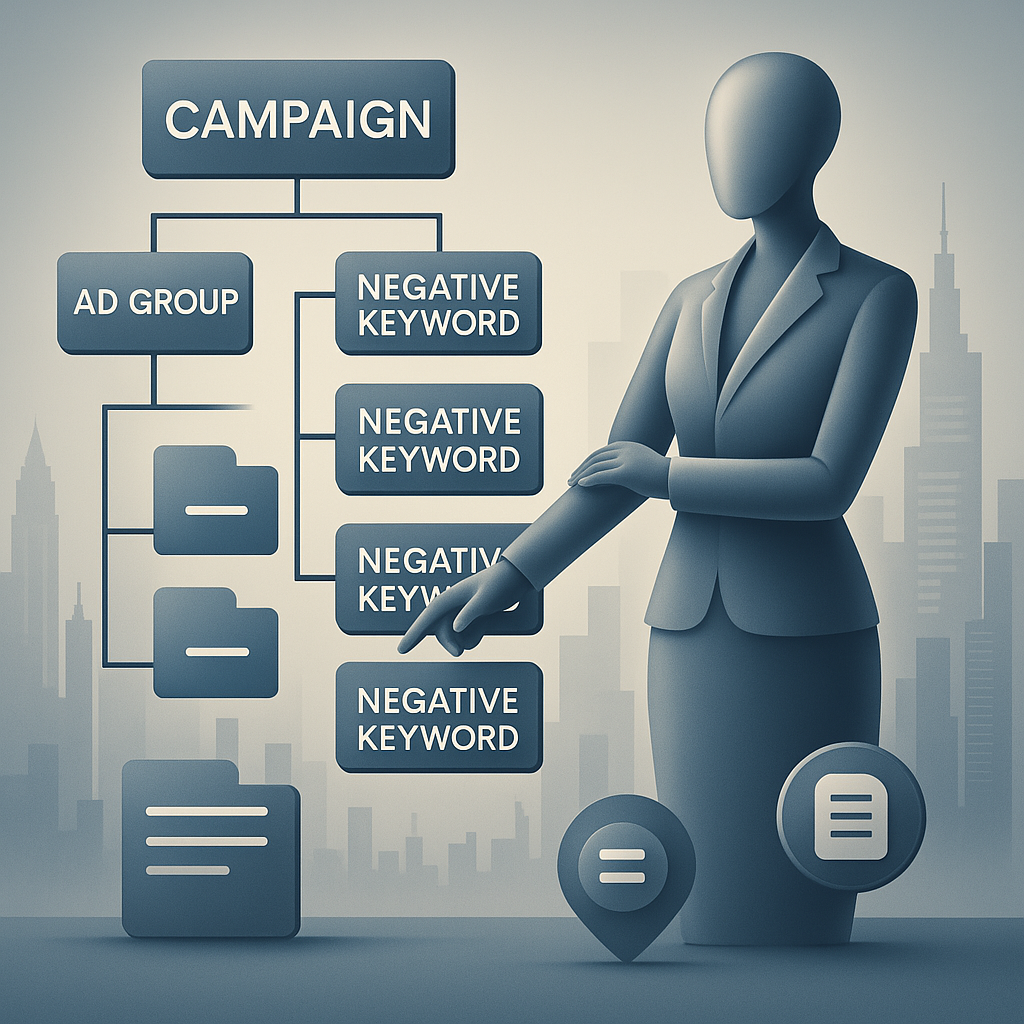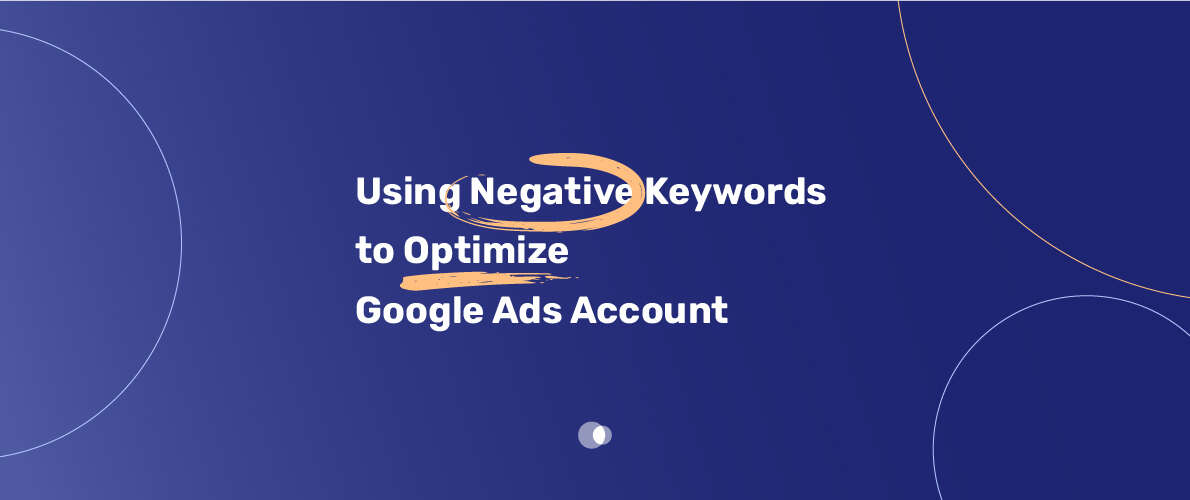In the fast-paced world of digital ads, making your Google Ads account better is key to lasting success. One effective strategy is using Negative Keywords to Optimize Google Ads Account performance. These keywords ensure your ads reach the right people, saving you money and boosting your return on investment (ROI).
Table of Contents
Google Ads optimization, PPC ads, and making your campaigns work better are all important. One key way to Optimize Google Ads Account performance is by using negative keywords. This strategy helps you target your ads better, ensuring they show up for the right people, not just anyone.

Key Takeaways
Negative Keywords in Google Ads
├── Benefits of Negative Keywords
│ ├── Improve Ad Relevance
│ ├── Reduce Wasted Ad Spend
│ └── Increase ROI
├── Role in Targeting
│ └── Fine-Tune Search Term Targeting
│ └── Ensure Ads Reach Relevant Audience
├── Ongoing Management
│ └── Regular Review and Updates
│ └── Maintain Campaign Effectiveness
└── Strategic Value
└── Optimization of Google Ads Performance
- Negative keywords help improve ad relevance and reduce wasted ad spend.
- Implementing negative keywords can lead to a higher ROI for your Google Ads campaigns.
- Negative keywords allow you to fine-tune your search term targeting, ensuring your ads are displayed to the most relevant audience.
- Regularly reviewing and updating your negative keyword lists is crucial for maintaining the effectiveness of your ad campaigns.
- Leveraging negative keywords is a strategic approach to optimizing your Google Ads account and driving better performance.
Understanding the Fundamentals of Negative Keywords in Google Ads
Negative keywords are key to making your Google Ads better. They help you target the right people and improve your ad’s performance. Knowing about different negative keyword types and how they affect your ads is vital for success.
Types of Negative Keyword Match Types
Google Ads has several negative keyword match types. They help you avoid showing ads to the wrong people. This makes your campaigns more efficient.
- Negative broad match: Keeps your ads from showing up in searches with related keywords.
- Negative phrase match: Blocks ads from showing in searches with exact or similar phrases.
- Negative exact match: Stops ads from showing in searches that match the keyword exactly.
Reade more :
How Negative Keywords Impact Ad Performance
Using negative keywords can greatly improve your ad’s performance. They help you avoid wasting money on the wrong searches. This leads to better traffic quality and a higher return on investment for your ads.
The Difference Between Regular and Negative Keywords
Regular keywords show your ads to the right people. Negative keywords keep your ads from showing to the wrong people. By using both, you can make your ads more targeted and effective.
The Strategic Impact of Negative Keywords on Ad Spend
Google Ads Optimization is more than just picking the right keywords. Incorporating negative keywords is a crucial strategy for ad budget optimization, cost-per-click reduction, and impression share improvement. By excluding specific terms, you can ensure your ads reach only the most relevant audience.
Adding negative keywords to your campaigns boosts your quality score and cuts down on irrelevant clicks. This makes your ad budget work better and improves campaign performance. Ads that match what users are searching for get more clicks, leading to better ad spend returns.
| Metric | Before Negative Keywords | After Negative Keywords |
| Cost-per-Click (CPC) | $2.50 | $1.75 |
| Click-Through Rate (CTR) | 3.2% | 5.1% |
| Conversion Rate | 2.1% | 3.8% |
| Cost per Acquisition (CPA) | $35.71 | $21.05 |
The table shows how negative keywords can improve key metrics. You see big drops in cost-per-click and cost per acquisition, and big increases in click-through and conversion rates. Using negative keywords smartly can make your ad spend go further, reach the right people, and boost your business results.
“Negative keywords are a powerful tool in the Google Ads arsenal, allowing marketers to fine-tune their campaigns and eliminate wasteful spending.”
Success with negative keywords comes from good research, constant monitoring, and being ready to change your strategy. By getting good at managing negative keywords, you can make your Google Ads work better and get the most out of your budget.
Essential Steps to Research Negative Keywords
Looking into the right negative keywords is key to improving your Google Ads account. By using keyword research tools, search query analysis, competitive intelligence, and industry-specific targeting, you can make your ad campaigns better. This leads to more value for your money.

Using Google Search Term Reports
The Google Ads Search Term Report is a great tool for finding good negative keywords. It shows you the search terms that led to your ads. This helps you spot terms that don’t fit your ad goals and should be blocked.
Competitor Analysis for Negative Keywords
Looking at your competitors’ ad strategies can also help a lot. By seeing what keywords they use and avoid, you can learn a lot. This knowledge can help you improve your competitive intelligence and target your ads better.
Industry-Specific Negative Keyword Lists
Industry-specific negative keyword lists are another useful starting point. These lists, made by experts, can quickly show you common mistakes in your field. They help you add the right negative keywords fast.
“Effective negative keyword research is the foundation of a successful Google Ads campaign. By leaving no stone unturned, you can consistently optimize your ad spend and improve your overall performance.”
Common Mistakes When Implementing Negative Keywords
Using negative keywords is a smart way to make your Google Ads better. But, many advertisers make common mistakes. These errors can cause negative keyword errors, over-exclusion of customers, under-utilization of the tool, and campaign conflicts from poor organization.
One big problem is over-exclusion of good keywords. Advertisers might block too many potential customers. This can lead to missing out on chances and lower profits.
On the other hand, not using negative keywords enough is also a mistake. If you don’t add the right keywords, you waste money on wrong searches. This means you get less targeted traffic and your campaign doesn’t work as well.
Also, not organizing negative keywords well can cause campaign conflicts. This happens when negative keywords in one campaign hurt another. This messes up your whole negative keyword plan.
To avoid these mistakes, you need a smart plan. Use search term reports, check out your competitors, and use specific negative keyword lists. This way, you can make your Google Ads work better.
Remember, managing negative keywords is an ongoing job. You need to keep checking and updating your strategy. By doing this, you can make sure your Google Ads are as effective and profitable as possible.
Using Negative Keywords to Optimize Google Ads Account
As a digital marketer, you know how important account structure optimization is. Negative keywords play a big role in making your Google Ads campaigns better. Using them right can make your ads more efficient and save you money.
Campaign Level vs. Ad Group Level Implementation
You can use negative keywords at the campaign or ad group level. At the campaign level, you can block off search queries that don’t match your ads. This makes sure your ads reach the right people. At the ad group level, you can target specific products or services more precisely.
Creating Negative Keyword Lists
- Start by researching keywords that might hurt your ad performance.
- Look at search term reports to find queries that don’t match your goals.
- Use competitor and industry negative keyword lists to block more irrelevant searches.
- Group your negative keywords by theme to make them easier to manage.
Regular Maintenance and Updates
Keeping your negative keyword lists up to date is key. Check your search term reports and campaign results often. Update your negative keywords as needed. This keeps your ads in front of the right people and saves you money on bad clicks.
“By using negative keywords, you can make your Google Ads campaigns better. This reduces unwanted traffic and saves money on ads.”
Learning to use negative keywords well is crucial for managing your Google Ads campaigns. Spend time creating detailed negative keyword lists. Stay active in updating them to get the best results from your ads.
Advanced Negative Keyword Strategies for Better ROI
Improving your Google Ads performance is more than just using basic negative keywords. Smart marketers use advanced strategies to see big gains in ROAS improvement and conversion rate optimization. We’ll show you how to use negative keywords for better audience targeting and predictive optimization.
Negative Keyword-Driven Audience Segmentation
Negative keywords do more than block unwanted traffic. They help you target your audience better. By looking at search queries and negative keyword patterns, you learn about your customers. This info helps you create more targeted ads and bids.
Predictive Negative Keyword Implementation
Great advanced PPC tactics use past data to predict the future. By studying your account’s history, you find top-performing negative keywords. Adding these keywords early can save you from costly, low-converting clicks.
Also, combining negative keywords with other tactics like bid adjustments and ad testing boosts your ROAS improvement. This mix can greatly improve your campaign’s performance.
“Negative keywords are the unsung heroes of PPC optimization. By leveraging advanced strategies, marketers can transform their accounts from good to great.”

The secret to negative keywords’ full power is a data-driven, holistic approach. Keep refining your strategies and adapting to market changes. This way, your Google Ads account will stay a top conversion rate optimization tool.
Tools and Resources for Negative Keyword Management
Managing negative keywords in your PPC management software can really boost your Google Ads account. There are many tools and resources to help you do this efficiently. They make your campaigns work better.
Google Ads Editor Features
Google Ads Editor is a free app for desktops. It has great features for handling negative keywords. You can easily add, remove, and edit keywords in many campaigns at once.
It also shows how well your negative keywords are doing. This helps you find the most effective ones.
Third-Party Keyword Research Tools
Google Ads Editor has its own features, but third-party tools like keyword planner and SEMrush can help more. Ahrefs is one such tool. It has a big database of keywords.
With these tools, you can find specific negative keywords for your industry. This improves your Google Ads campaigns a lot.
Using these tools, you can manage negative keywords better. This reduces waste and boosts your PPC management software results.
“Proper negative keyword management is a critical component of a successful Google Ads strategy. The right tools and resources can make all the difference in optimizing your campaigns for maximum ROI.”
Measuring the Success of Your Negative Keyword Strategy
As a savvy PPC marketer, it’s key to track your negative keyword strategy’s performance. Analyzing PPC metrics gives you insights into how well your negative keywords work. This helps you make better decisions to boost your campaign’s success.
Watching conversion tracking is a must. It shows how negative keywords affect your traffic quality and lead generation. Also, A/B testing your negative keywords can find the best combinations to increase conversions and cut down on ad spend.
Don’t forget about analytics integration. Linking your Google Ads with your web analytics lets you dive deeper into your negative keyword performance. This way, you can see how users who avoid your ads behave, helping you fine-tune your strategy.
| PPC Metric | Importance in Negative Keyword Strategy |
| Conversion Rate | Measures the impact of negative keywords on driving qualified leads and sales |
| Click-Through Rate (CTR) | Indicates the relevance and effectiveness of your negative keyword targeting |
| Cost per Conversion | Helps evaluate the cost-efficiency of your negative keyword implementation |
| Impression Share | Reveals the reach and visibility of your ads after applying negative keywords |
By keeping an eye on these PPC metrics and doing regular A/B testing, you can improve your negative keyword strategy. This will help you spend your ad budget wisely and see real improvements in your campaign’s performance.
Organizing negative keywords well in a Google Ads account is key to better campaign performance. It helps you use your ad budget more wisely. By setting up a smart negative keyword structure, your ads reach the right people. This cuts down on waste and boosts your return on investment (ROI).
Best Practices for Negative Keyword Organization
Creating a clear account hierarchy is a top practice. This means grouping similar negative keywords together. You can do this at the campaign or ad group level, based on your needs. This makes it easier to manage and update your strategy as your business grows.
Using shared negative lists is also crucial. These are big collections of keywords that you can use across many campaigns or ad groups. It saves time and keeps your strategy consistent. This way, your negative keyword structure stays strong and flexible, even as your account gets bigger.
Lastly, keeping your negative keyword lists up to date is vital. As search habits and trends change, so should your keywords. Look at search term reports and check out what your competitors are doing. This helps you find new keywords to add, keeping your ads sharp and effective.
| Best Practices for Negative Keyword Organization | Description |
| Establish a Clear Account Hierarchy | Group related negative keywords together at the campaign or ad group level to maintain a cohesive negative keyword strategy. |
| Utilize Shared Negative Lists | Create centralized collections of negative keywords that can be applied across multiple campaigns or ad groups, promoting consistency. |
| Regularly Review and Update | Analyze search term reports and competitor data to identify new negative keyword opportunities and adapt your organization as needed. |
By following these best practices, you can make the most of your Google Ads account. You’ll get more targeted traffic, spend less on ads, and see better results overall.
Real-World Case Studies: Negative Keywords in Action
Negative keywords are a key tool for better Google Ads campaigns. They help improve performance and increase ROI. Let’s look at success stories from different industries that used negative keywords well.

Success Stories from Various Industries
An online clothing store used negative keywords to block unwanted searches. Keywords like “free” and “discount” were costing them money without selling anything. After using negative keywords, they spent 25% less on ads and made 15% more from each ad.
A cloud-based project management platform also used negative keywords. They targeted “free trials” and “demos” to focus on paid plans. This made their leads 20% better and their conversion rate 12% higher.
Before and After Performance Metrics
| Metric | Before Negative Keywords | After Negative Keywords |
| Ad Spend | $50,000 per month | $37,500 per month |
| Conversion Rate | 2.5% | 3.2% |
| ROAS | $4 per $1 spent | $5 per $1 spent |
These examples show how negative keywords can greatly improve PPC campaigns. They help reduce ad spend, boost conversion rates, and increase ROI. By using these strategies, marketers can make their campaigns much more effective.
Conclusion
In this guide, we’ve looked at how negative keywords can boost your Google Ads account. We’ve covered the basics and advanced strategies to improve your PPC campaigns. This helps you get a better return on your investment.
Using negative keywords is key to optimizing your Google Ads. It helps you avoid unwanted traffic and saves ad spend. By following the best practices in this article, you can manage negative keywords well. This unlocks your Google Ads account’s full potential.
Improving your PPC success takes ongoing effort. Partnering with a Google Ads agency can make a big difference in streamlining your efforts. Keeping your negative keyword lists up to date is crucial. Always check your search term reports and tweak your strategies. With the right approach to negative keywords, you can excel in Google Ads optimization and get the most from your ads.
FAQs
What are the different types of negative keyword match types?
Google Ads has three main negative keyword match types. These are broad match negative, phrase match negative, and exact match negative. Each type affects how well a negative keyword filters out unwanted searches.
How do negative keywords impact ad performance?
Negative keywords make your ads more relevant by avoiding unwanted searches. This can boost your ad’s click-through rate and quality score. It also helps you spend your budget more wisely.
What is the difference between regular keywords and negative keywords?
Regular keywords are the terms you want your ads to show for. Negative keywords are the terms you don’t want to target. Using negative keywords helps refine your ad targeting.
How can I research effective negative keywords for my Google Ads account?
You can research negative keywords by analyzing search term reports and studying competitors. You can also use industry-specific lists. These methods help you find search terms to exclude from your campaigns.
What are some common mistakes to avoid when implementing negative keywords?
Avoid over-excluding potential customers and not using negative keywords enough. Also, keep your negative keyword lists organized and avoid conflicts between different levels of your campaigns. Planning and maintenance are crucial.
How can I use negative keywords to optimize my Google Ads account?
To optimize, use negative keywords at both campaign and ad group levels. Create detailed lists and regularly update your strategy. This keeps your ads relevant to current search trends.
What advanced negative keyword strategies can I use to improve ROI?
Advanced strategies include using negative keywords for audience targeting and predicting future needs based on historical data. Integrating them with other optimization techniques can also boost ROI.
What tools and resources are available for managing negative keywords?
Google Ads Editor has features for managing negative keywords. Tools like SEMrush and Ahrefs help identify and organize them across your account.
How can I measure the success of my negative keyword strategy?
Track metrics like click-through rate, cost-per-click, and conversion rate. A/B testing and ongoing analysis help evaluate your strategy’s impact.
What are some best practices for organizing negative keywords?
Organize your negative keywords logically and use shared lists across campaigns. Keep your approach consistent throughout your Google Ads account.



